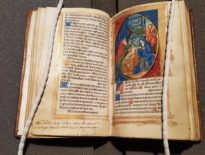As it's the anniversary of the "Lady in the Tower" letter today, a letter said to have been written by Queen Anne Boleyn on 6th May 1536, I thought I'd answer this question from member Real Tudor Lady:
"What is your opinion on the authenticity of the last letter of Queen Katherine of Aragon to Henry VIII, and the last letter of Anne Boleyn, 'The Lady in the Tower " letter, to Henry VIII? Are they both fake or real?"
The letter said to be from Catherine of Aragon was written in her final days, in January 1536, and reads:
"My most dear lord, king and husband,
The hour of my dear now drawing on, the tender love I owe you forceth me, my case being such, to commend myself to you, and to put you in remembrance with a few words of the health and safeguard of your soul which you ought to prefer before all worldly matters, and before the care and pampering of your body, for the which you have cast me into many calamities and yourself into many troubles. For my part I pardon you everything and I wish to devoutly pray to God that He will pardon you also. For the rest, I commend unto you our daughter Mary, beseeching you to be a good father unto her, as I have heretofore desired. I entreat you also, on behalf of my maids, to give them marriage portions, which is not much, they being but three. For all my other servants, I solicit the wages due to them, and a year or more, lest they be unprovided for. Lastly, I make this vow, that mine eyes desire you above all things."
Now, while one of Catherine's biographer's, Giles Tremlett, believes that it "is almost certainly fictitious", here are the views of other historians:
- Linda Porter includes it in her biography of Mary I, "Mary Tudor", stating that Catherine had it dictated.
- Amy Licence, in "Catherine of Aragon: An Intimate Life of Henry VIII's True Wife", writes that "it is by no means certain that this is a genuine letter, surviving in a later document rather than the State Papers and Letters."
- Anna Whitelock includes it in her biography of Mary I, but makes no judgement on it.
For me, personally, it rings true with Catherine's behaviour and her character. Linda Porter writes "In its dignified pathos and remembrance of a great and, for the writer, enduring love, it is one of the most moving farewells in the English language", and I'm in complete agreement. If it was fictitious, I'm not sure that the writer would have bothered with the financial details.
Another 1536 letter is the one said to be written on 6th May 1536 while Queen Anne Boleyn was imprisoned in the Tower of London awaiting her trial. The title, in another hand, reads "To the King from the Lady in the Tower". In the letter, Anne emphasises her innocence and asks the King to "let not any light Fancy, or bad Counsel of mine Enemies, withdraw your Princely Favour from me". She also asks for a "lawful trial" and puts her present predicament down to the King’s affection settling on another, i.e. her own lady-in-waiting, Jane Seymour.
Here is the text:
"Sir, your Grace's displeasure, and my Imprisonment are Things so strange unto me, as what to Write, or what to Excuse, I am altogether ignorant; whereas you sent unto me (willing me to confess a Truth, and so obtain your Favour) by such a one, whom you know to be my ancient and professed Enemy; I no sooner received the Message by him, than I rightly conceived your Meaning; and if, as you say, confessing Truth indeed may procure my safety, I shall with all Willingness and Duty perform your Command.
But let not your Grace ever imagine that your poor Wife will ever be brought to acknowledge a Fault, where not so much as Thought thereof proceeded. And to speak a truth, never Prince had Wife more Loyal in all Duty, and in all true Affection, than you have found in Anne Boleyn, with which Name and Place could willingly have contented my self, as if God, and your Grace's Pleasure had been so pleased. Neither did I at any time so far forge my self in my Exaltation, or received Queenship, but that I always looked for such an Alteration as now I find; for the ground of my preferment being on no surer Foundation than your Grace's Fancy, the least Alteration, I knew, was fit and sufficient to draw that Fancy to some other subject.
You have chosen me, from a low Estate, to be your Queen and Companion, far beyond my Desert or Desire. If then you found me worthy of such Honour, Good your Grace, let not any light Fancy, or bad Counsel of mine Enemies, withdraw your Princely Favour from me; neither let that Stain, that unworthy Stain of a Disloyal Heart towards your good Grace, ever cast so foul a Blot on your most Dutiful Wife, and the Infant Princess your Daughter.
Try me, good King, but let me have a Lawful Trial, and let not my sworn Enemies sit as my Accusers and Judges; yes, let me receive an open Trial, for my Truth shall fear no open shame; then shall you see, either mine Innocency cleared, your Suspicion and Conscience satisfied, the Ignominy and Slander of the World stopped, or my Guilt openly declared. So that whatsoever God or you may determine of me, your Grace may be freed from an open Censure; and mine Offence being so lawfully proved, your Grace is at liberty, both before God and Man, not only to execute worthy Punishment on me as an unlawful Wife, but to follow your Affection already settled on that party, for whose sake I am now as I am, whose Name I could some good while since have pointed unto: Your Grace being not ignorant of my Suspicion therein.
But if you have already determined of me, and that not only my Death, but an Infamous Slander must bring you the enjoying of your desired Happiness; then I desire of God, that he will pardon your great Sin therein, and likewise mine Enemies, the Instruments thereof; that he will not call you to a strict Account for your unprincely and cruel usage of me, at his General Judgement-Seat, where both you and my self must shortly appear, and in whose Judgement, I doubt not, (whatsover the World may think of me) mine Innocence shall be openly known, and sufficiently cleared.
My last and only Request shall be, That my self may only bear the Burthen of your Grace's Displeasure, and that it may not touch the Innocent Souls of those poor Gentlemen, who (as I understand) are likewise in strait Imprisonment for my sake. If ever I have found favour in your Sight; if ever the Name of Anne Boleyn hath been pleasing to your Ears, then let me obtain this Request; and I will so leave to trouble your Grace any further, with mine earnest Prayers to the Trinity to have your Grace in his good keeping, and to direct you in all your Actions.
Your most Loyal and ever Faithful Wife, Anne Bullen
From my doleful Prison the Tower, this 6th of May."
The letter was first published by Lord Herbert in his 1649 "The Life and Raigne of King Henry the Eighth" and then used again by Bishop Burnet in 1679. Burnet claimed to have found it, along with Sir William Kingston's letters, "lying among Cromwell's other papers. Like Kingston's letters to Cromwell, it was damaged during a fire in 1731 but is still legible.
Now, there are problems with this letter, issues that point to it being fake:
- The handwriting does not match Anne Boleyn's other letters.
- The queen signs herself "Anne Bullen", whereas Anne tended to use "Anne the Queen" or the "Boleyn" or the "de Boulaine" spellings.
- That it still exists - Wouldn't Cromwell have wanted rid of it?
- The heading at the top: "To the King from the Lady in the Tower" - It seems rather romantic or dramatic. If Cromwell wrote it, wouldn't he have just put "To the King from the Queen"?
- The style, which does not seem consistent with Anne's other letters
- The reproving tone and provocative content - The writer is claiming that the king instigated the plot so that he could marry Jane Seymour. Would Anne risk angering and insulting Henry in this way? Her execution speech followed the usual form of praising the king and accepting her death.
However, the spelling and handwriting can be explained by Anne dictating it to one of her ladies while she was imprisoned, or by one of Cromwell's secretaries creating it as a copy of the original letter.
Historian Gareth Russell points out another problem with the letter, in an article he wrote on his blog back in 2010. He notes that the writer declares that "that Anne’s queenship had 'no surer foundation than your Grace’s fancy', which is something we know Anne did not believe. As early as 1530, the Venetian ambassador to London was reporting that Anne believed passionately that God had chosen her to be queen of England instead of Katherine, just as in Biblical times He had chosen Esther to replace Queen Vashti. Again, however, when it came to this letter, she could have been flattering Henry’s ego or once again expressing herself in her beloved hyperbole." - see http://garethrussellcidevant.blogspot.com/2010/05/may-6th-1536-mystery-of-queens-letter.html
Author Sandra Vasoli has researched this letter in detail and written a book on it, so I'll leave you with a video she made on it and also a link to an article she wrote for the Anne Boleyn Files on it - https://www.theanneboleynfiles.com/6-may-1536-letter-tower-sandra-vasoli/. You can find out even more about Sandi's research in her book Anne Boleyn's Letter from the Tower: A New Assessment - click here.
What's my own personal view on the letter? I agree with Gareth Russell's conclusion that Anne did write a letter to the king, but that this is just based on that letter and is not truly authentic. Certain things ring true, others not so much. It's a bit of a mish-mash in my view.
What do Tudor Society members think?



Firstly, thanks very much for your honest and detailed response to my question, which we have been discussing in detail on the ABF site today. I agree the letter from Katherine to Henry is a very loving and emotional last letter from a separated, distressed but loving dying wife. I don’t doubt its authenticity.
The Anne Boleyn letter Lady In the Tower, the title being added later, not on the original, is problematic. I believe its as genuine as it can be, but there are a lot of questions to really be certain. Only part of the letter survived and two transcribed copies. Was it put together from the original? It’s very difficult to know. Sandra Vasoli has done great research but I think there are still unanswered questions. More research is needed.
Thanks again for answering my question.
Thanks. I appreciate this as well. Claire, I’m looking forward to hearing you on Natalie Grueninger’s podcast soon! Michelle t
Thanks Claire and All. I do agree with your comments, that as much as we would like to believe that we have a document with Anne’s thoughts and wishes to the King just prior to her execution, there are too many questions and inconsistencies regarding it, which put its validity into question..